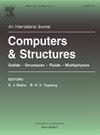Multi-population competition genetic algorithm for assessing long-span cable-supported bridge girder’s maximum deflections and rotation angles under live loads: A direct optimization task solution
IF 4.4
2区 工程技术
Q1 COMPUTER SCIENCE, INTERDISCIPLINARY APPLICATIONS
引用次数: 0
Abstract
This study addresses the stability problem of long-span cable-supported bridges (CSBs) under live loads, which requires an accurate estimation of maximum girder deflection and rotation angle. In contrast to the cumbersome influence line method or analytical method, which ignores the structural nonlinearity of this bridge type or uses too many constraint conditions, we convert this problem into an optimization task. Since the number of segments of distributed live loads under which maximum girder deflection and rotation angle occur (i.e., the number of optimization variables) is unknown due to CSB’s structural complexity, a multi-population competition genetic algorithm (MPCGA), inspired by the population competition theory in ecology, is applied. It incorporates the Lotka-Volterra competition model to depict the changing sizes of the competing populations. We designed the interspecies migration and exchange mechanism for the above engineering problem and ran ANSYS to compute individual fitness. This algorithm offers high accuracy and efficiency in solving the maximum girder deflection and rotation angle of the long-span CSB, the positions where the maximum girder deflection and rotation angle occur, and the corresponding live load patterns. Finally, the proposed method is validated by a case study of a hybrid CSB with a main span of 1400 m. The calculation results obtained via the conventional influence line and proposed methods are compared, proving the latter’s supremacy.
多群体竞争遗传算法用于评估大跨度斜拉桥梁在活载荷作用下的最大挠度和旋转角度:直接优化任务解决方案
本研究探讨了大跨度斜拉桥(CSB)在活荷载作用下的稳定性问题,这需要对最大梁挠度和旋转角进行精确估算。与繁琐的影响线法或分析法相比,我们将这一问题转化为优化任务,因为影响线法或分析法忽视了这种桥梁类型的结构非线性,或使用了太多的约束条件。由于 CSB 结构的复杂性,出现最大梁体挠度和旋转角度的分布式活载的节段数量(即优化变量的数量)是未知的,因此我们采用了多种群竞争遗传算法 (MPCGA),其灵感来自生态学中的种群竞争理论。它采用 Lotka-Volterra 竞争模型来描述竞争种群规模的变化。我们为上述工程问题设计了种间迁移和交换机制,并运行 ANSYS 计算个体适应度。该算法在求解大跨度 CSB 的最大大梁挠度和旋转角度、最大大梁挠度和旋转角度出现的位置以及相应的活载荷模式方面具有较高的准确性和效率。最后,通过对主跨为 1400 米的混合式 CSB 进行案例研究,对所提出的方法进行了验证。通过比较传统影响线法和所提出方法的计算结果,证明了后者的优越性。
本文章由计算机程序翻译,如有差异,请以英文原文为准。
求助全文
约1分钟内获得全文
求助全文
来源期刊

Computers & Structures
工程技术-工程:土木
CiteScore
8.80
自引率
6.40%
发文量
122
审稿时长
33 days
期刊介绍:
Computers & Structures publishes advances in the development and use of computational methods for the solution of problems in engineering and the sciences. The range of appropriate contributions is wide, and includes papers on establishing appropriate mathematical models and their numerical solution in all areas of mechanics. The journal also includes articles that present a substantial review of a field in the topics of the journal.
 求助内容:
求助内容: 应助结果提醒方式:
应助结果提醒方式:


